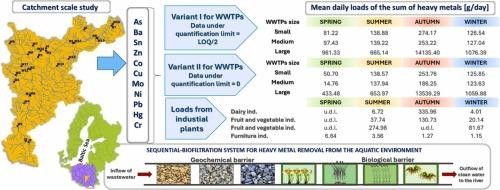Wastewater as a Driver of Heavy Metal Pollution in River Catchments – a study of possible scenarios
IF 11.3
1区 环境科学与生态学
Q1 ENGINEERING, ENVIRONMENTAL
引用次数: 0
Abstract
Heavy metals can enter rivers i.a. from point sources such as wastewater treatment plants (WWTPs) and industrial plants with inadequately-treated wastewater. The present article examines (i) the impact of WWTPs and industrial facilities on the pollution of the Pilica River, (ii) heavy metal loads along its continuum, and (iii) the identification of common pollution patterns in wastewater and river water, and the effect of their physicochemical properties.A novel aspect of this study is the use of two distinct data calculation approaches: Variant 1 -values below the quantification limit (LOQ) were replaced with LOQ/2, Variant 2- LOQ replaced with zero. Analyses have shown that pollution scenarios differ depending on the calculation method used. Nevertheless, regardless of the calculation method, the general conclusions that can be drawn are: i) among WWTPs, the highest heavy metal concentrations are generated by the smallest plants, ii) the highest loads by the largest ones, which is related i.a. to the size of their flow, iii) industrial plants are significant sources of point pollution of rivers, with arsenic, tin, zinc, cobalt, copper, molybdenum, nickel, lead, chromium, mercury and barium being detected in wastewater. The most common heavy metal in the Pilica was found to be Barium, with the highest loads observed in winter (66.29-216.98 kg/day), and depending on the season, arsenic, copper and nickel were also detected.The innovative aspect of the work is an example of modification of the sedimentation-biofiltration system as a sustainable solution for removing heavy metals from treated wastewater.

污水是河流集水区重金属污染的驱动因素-可能情况的研究
重金属可以从污水处理厂和废水处理不充分的工业工厂等点源进入河流。本文研究了(i)污水处理厂和工业设施对皮利卡河污染的影响,(ii)沿其连续体的重金属负荷,以及(iii)废水和河水中常见污染模式的识别及其物理化学性质的影响。本研究的一个新颖方面是使用两种不同的数据计算方法:变量1 -低于定量限制(LOQ)的值被LOQ/2取代,变量2- LOQ被替换为零。分析表明,不同的计算方法会产生不同的污染情况。然而,无论采用何种计算方法,可以得出的一般结论是:1)在污水处理厂中,最小的工厂产生的重金属浓度最高,2)最大的工厂产生的负荷最高,这与它们的流量大小有关,3)工业工厂是河流点源污染的重要来源,废水中检测到砷、锡、锌、钴、铜、钼、镍、铅、铬、汞和钡。其中,钡含量最高,冬季最高(66.29 ~ 216.98 kg/d),砷、铜、镍也随季节变化而变化。这项工作的创新方面是对沉淀-生物过滤系统进行改造的一个例子,作为从处理过的废水中去除重金属的可持续解决方案。
本文章由计算机程序翻译,如有差异,请以英文原文为准。
求助全文
约1分钟内获得全文
求助全文
来源期刊

Journal of Hazardous Materials
工程技术-工程:环境
CiteScore
25.40
自引率
5.90%
发文量
3059
审稿时长
58 days
期刊介绍:
The Journal of Hazardous Materials serves as a global platform for promoting cutting-edge research in the field of Environmental Science and Engineering. Our publication features a wide range of articles, including full-length research papers, review articles, and perspectives, with the aim of enhancing our understanding of the dangers and risks associated with various materials concerning public health and the environment. It is important to note that the term "environmental contaminants" refers specifically to substances that pose hazardous effects through contamination, while excluding those that do not have such impacts on the environment or human health. Moreover, we emphasize the distinction between wastes and hazardous materials in order to provide further clarity on the scope of the journal. We have a keen interest in exploring specific compounds and microbial agents that have adverse effects on the environment.
 求助内容:
求助内容: 应助结果提醒方式:
应助结果提醒方式:


